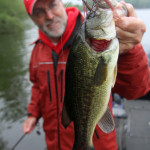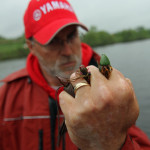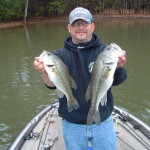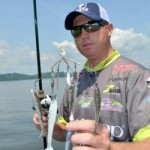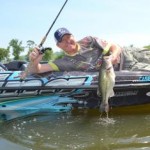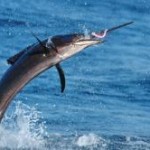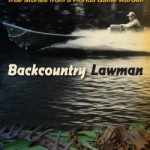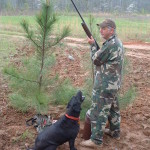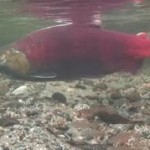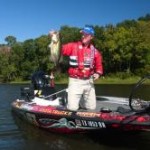How a non-traditional swim jig technique can help you crack conditioned fish
By Steve Pennaz
Like a lot of anglers, I grew up fishing bass jigs traditionally, pounding cover with an endless drop-lift-drop-lift routine. And while I caught fish, I didn’t fully grasp how truly versatile jigs are—and how they can be fished in ways that can crack conditioned bass when everything else fails.
My “Eureka” moment came on a trip with a saltwater guide who’d throw his jig out as far as he could and rip it back to the boat. Watching him catch fish taught me that we all have preconceived ideas about how we’re supposed to fish jigs.
During a TV shoot in Texas a few years back the producers asked me to burn the bait back to boat so they could get a shot of the reel handle rotating. So I start drag racing a jig through two feet of water and all of sudden an 8-pound bass grabs the bait. Here again, I never would have fished a jig that fast, but it produced a solid fish and once again opened my eyes to the efficacy of breaking conventions.
And why is that?
Bass are typically released after they are caught, which means a percentage of any bass population has been “conditioned.” Larger fish have seen it all. That’s why fishing new bait designs, colors and techniques are essential to staying ahead of the curve.
Like modifying your jig routine to offer bass something different.
We’ve been taught to fish the three main jig styles according to head design. For example, traditional round-head designs are usually flipped to cover on heavy braid, while a football head is typically dragged over bottom. The keel head (swim jig) is designed to slither through grass and other cover, usually higher in the water column or even bulging the surface on a steady retrieve.
But a round-head jig can also be used as a punch bait to penetrate thick vegetation. Likewise, a football head can be fished on a steady retrieve, even burned back to the boat. The heavy weight typically keeps it down, and in situations like riprap, a football head will bounce from rock to rock like a crankbait. I’ve also used footballs in shallow water, burning them over weed tops like a silent spinnerbait—definitely not the norm.
Roller Coaster Swimming
Yet, of all three major jig head designs, the keel head (or swim jig) is probably the most versatile. Case in point, I don’t often fish them with the rod tip close to the water using a slow, steady retrieve. I like to activate the trailer tail by swimming it three or four feet and letting it glide back to the bottom on a semi-taut line, then repeating until the bait is back to the boat. I call it “roller coaster” swimming.
The bait spends very little time on the bottom, and this retrieve offers multiple triggering points on every cast—there’s strike potential during the sweep, the drop and the pause. The technique works in channel areas, flats, around stumps, and open areas off emergent vegetation like cattails—and a lot of other areas, too.
When you watch what happens underwater, the sweep makes a trailer like a 4-inch PowerBait grub or Havoc Beat Shad paddletail go crazy, then come to an abrupt stop on the pause, then beat again like crazy again on the glide. Get the cadence right it and the presentation seems almost magical. And it’s a lot more fun than the standard jig retrieve.
Fall Rate
The most crucial component of the ‘roller coaster’ system is fall rate. Head weight, skirt bulk and trailer all factor in. My go-to swim jig head size for shallow water is 3/8-ounce. Go too light and the bait doesn’t fall fast enough; go too heavy and you drag bottom at typical retrieval speeds. However, as bass orient in and around deep weedlines later in the summer you may want to go with a heavier swim jig fished with a slower ‘roller coaster’ retrieve to achieve maximum depth.
Another essential component of the ‘roller coaster’ program is the use of fluorocarbon line. I’ll typically fish 12- or 15-pound test, sometimes moving up to 20 if I’m on a body of water with big fish and lots of cover. Fluoro’s slow stretch means excellent sensitivity, solid hooksets and the line’s sinking tendency gives the bait a natural appearance on the retrieve. Fluoro’s near-invisibility under water can be key in shallow, clear waters. Most importantly, fluorocarbon helps keeps jigs near the bottom even at faster retrieves.
Next, a properly matched rod and reel can be a huge plus. I fish swim jigs on a fast-action medium heavy seven-foot and a medium-speed, low-profile 7.1:1 ratio baitcaster like the ultra-lightweight Abu Garcia Revo MGX. The reel takes in 28 inches of line for every turn of the reel handle; about the same as other reels geared 6.4:1.
More Tips
Besides using a soft plastic trailer that matches the color of the skirt/jig head and produces a gentle wobble, I’m a big fan of modifying stock weed guards. I like to remove about a third of the bristles to improve my strike-to-hook-up ratio. The addition of rattles is also a good idea at times, especially in more turbid waters.
Another thing: A lot of guys will immediately start reeling and let the rod load, letting the fish set the hook. When I get a hit I drop the rod tip and set the hook.
Final Word
My challenge to anglers fishing jigs is to think about how other anglers aren’t fishing them—then experiment with those methods. The ‘roller coaster’ swim jig routine is but one example of the myriad ways you can modify your jig game to catch more fish.
ABOUT
Award-winning fisherman/journalist, creator of Knot Wars, formerly with the North American Fishing Club, Steve Pennaz has launched Lake Commandos, a new brand that includes Lake Commando television/social media series on Pursuit Network and TuffTV.
